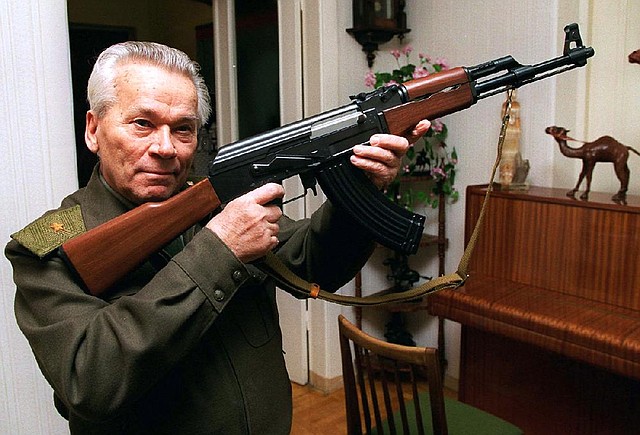Father of AK-47 design dies at 94
Kalashnikov parlayed fame into Russian political career
FILE- In this Wednesday, Oct. 29, 1997 file photo Mikhail Kalashnikov shows a model of his world-famous AK-47 assault rifle at home in the Ural Mountain city of Izhevsk, 1000 km (625 miles) east of Moscow, Russia. Kalashnikov, whose work as a weapons designer for the Soviet Union is immortalized in the name of the world’s most popular firearm, died Monday at the age of 94 in a hospital of the city of Izhevsk where he lived. The AK-47 has been favored by guerrillas, terrorists and the soldiers of many armies. An estimated 100 million guns are spread worldwide. (AP Photo/Vladimir Vyatkin, File)
Tuesday, December 24, 2013
Lt. Gen. Mikhail Kalashnikov - the arms designer credited by the Soviet Union with creating the AK-47, the first in a series of rifles and machine guns that would associate his name with modern war and become the most abundant firearms ever made - died Monday in Izhevsk, the capital of the Udmurtia republic, where he lived. He was 94.
Viktor Chulkov, a spokesman for the republic’s president, confirmed the death, the Itar-Tass news agency reported.
Born a peasant on the southern Siberian steppe, Kalashnikov had little formal education and claimed to be a self-taught tinkerer who combined innate mechanical skills with the study of weapons to conceive a rifle that achieved battlefield ubiquity.
His role in the rifle’s creation, and the attention showered on him by the Kremlin’s propaganda machine, carried him from conscription in the Red Army to senior positions in the Soviet arms-manufacturing bureaucracy and ultimately to six terms on the Supreme Soviet.
Tens of millions of Kalashnikov rifles have been manufactured. Their short barrels, steep front-sight posts and curved magazines made them a marker of conflict that has endured for decades. The weapons also became both Soviet and revolutionary symbols and widespread instruments of terrorism, child-soldiering and crime.
The general, who sometimes lamented the weapons’ unchecked distribution but took pride in having invented them and their reputation for reliability, weathered the collapse of the Soviet Union to assume a public role as a folk hero and unequivocal Russian patriot.
A Soviet nostalgist, he also served as the unofficial arms ambassador of the revived Russian state. He used public appearances to try to cast the AK-47’s checkered legacy in a positive way and to complain that knockoffs were being manufactured illegally by former Soviet allies and cutting into Russian sales.
The weapon, he said, was designed to protect his motherland, not to be used by terrorists or thugs.
“This is a weapon of defense,” he said. “It is not a weapon for offense.”
Kalashnikov’s public life resulted from a secret competition to develop the Soviet infantry rifle for the Cold War. The result was the AK-47 - an abbreviation for “the automatic by Kalashnikov” followed by the year the competition ended.
Kalashnikov, a senior sergeant at the time who had been injured in battle against German tanks, was credited with leading the design bureau that produced the AK-47 prototype. The Soviet Union began issuing a mass-produced version to soldiers in 1949.
The true AK-47 was short-lived. It was followed in the 1950s by a modernized version, the AKM, which retained its predecessor’s underlying design while reducing its weight and manufacturing time.
The rifles eventually filled armories throughout Eastern Europe and Asia and spread from war to war. The United States became an active purchaser, arming anti-Soviet fighters in Afghanistan in the 1980s and indigenous Afghan and Iraqi forces in recent years.
How essential the general was to creation of the Kalashnikov line has been subject to dispute. A post-Soviet account in the newspaper Pravda challenged his central role, asserting that two supervisors repeatedly modified his weapon during field trials. The general fiercely disputed suggestions the design was guided by others, but also said the rifle was the result of everyone who labored beside him.
The Kremlin embraced his version.
Mikhail Timofeyovich Kalashnikov was born in Kurya on Nov. 10, 1919. He was married twice, the second time to Ekaterina Kalashnikova, a technician in his design bureau. He is survived by a son from his first marriage, Viktor Kalashnikov, who is also an arms designer; a daughter from his second marriage, Elena Krasnovskaya; a stepdaughter, Nelya; and several grandchildren.
Front Section, Pages 2 on 12/24/2013
